Performing STEM activities is the perfect approach to learning science for kids.
Today, we are going to perform such a classic STEM activity using ‘Lemon Fruit’. This experiment offers a great visual demonstration to children revealing the science behind a battery.
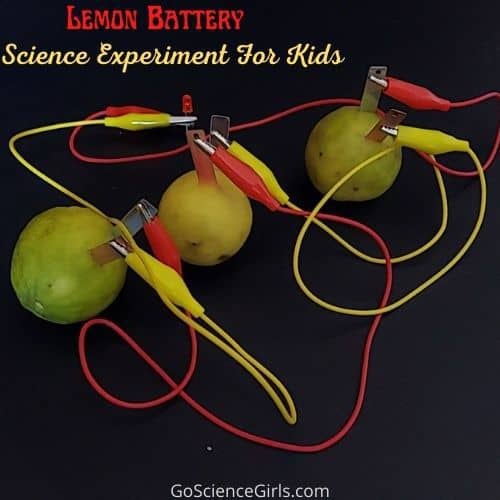
Using the ‘Lemon Light Experiment’, kids can create a direct current battery from Lemon. It is suitable for home-schoolers and elementary learners.
Making of Lemon Battery
Materials Required
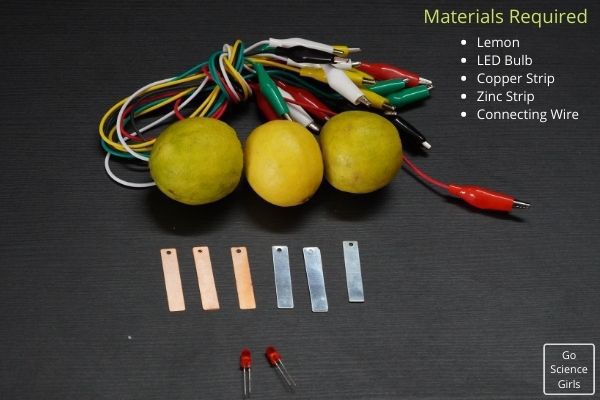
1) 3 Fresh Lemons (The more lemons you use, the more power or electricity you can create)
2) LED bulbs
3) Three Copper strips or nails around 2 inches in length
4) Four sets of electric wires that have alligator clips
5) Zinc-coated Galvanized strips or nails about 2 inches in length
6) A sharp knife
*Product Links are affiliate links – Your support is highly appreciated
Note: Adult supervision is compulsory if your children are performing this science activity on their own as we are dealing with electric circuits and knife.
Instructions to Perform Lemon Light Experiment
The lemon light experiment is a demonstrative activity to show children about electric circuits and how batteries work. Using this activity, we cannot make a high voltage current. Let us learn how lemon fruit generates low voltage electricity.
Step-1: As a first step, pick three to four fresh lemons and place them side by side intact. And give two vertical cuts about half-inch in length vertically on the surface of each lemon using a sharp knife. Such that, for a total of three lemons you will give six incisions. Make sure you leave some space in between two incisions on each lemon to fix the electric wire.
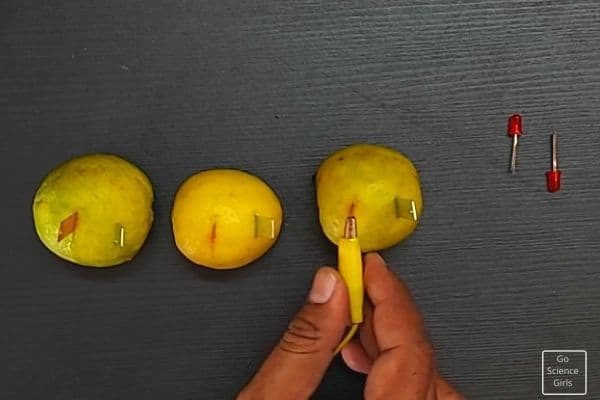
Step-2: Now pick three galvanized nails and insert them into the three incisions alternatively out of six incisions on the three lemons.
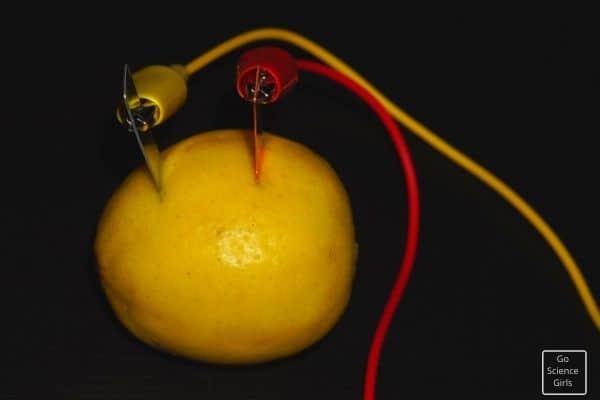
Step-3: Later, pick the three copper nailsand insert them into the other three incisions on the three lemons. At this point, three lemons are fixed with three copper and galvanized nails alternatively.
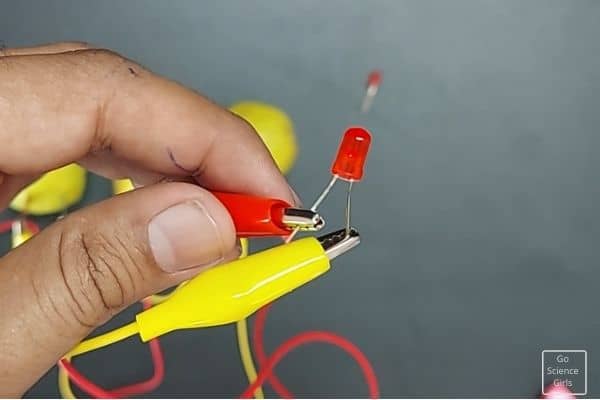
Step-4: Now connect the electrical wires in the manner: to the one galvanic strip of one lemon to the copper strip of another lemon using alligator clips. Follow the same rule as the other electric wire sets to create a chain. But make sure the alligator clips present at the end sides of the end lemons are left free i.e. one copper and one galvanized strip are set free.
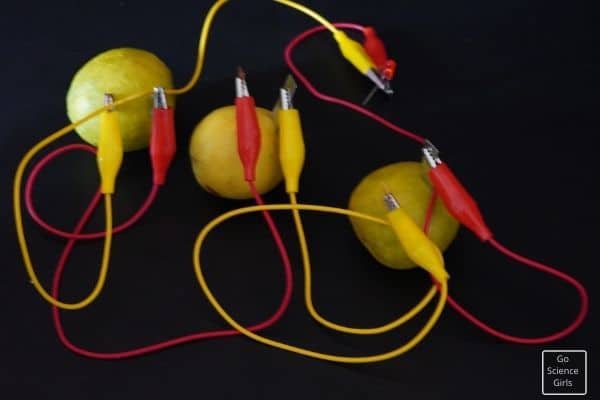
Step-5: As a final step, connect the free ends of alligator clips of electric wires on the end lemons to an LED bulb. Make sure you are connecting the first lemon alligator clip to the long part of the LED bulb while the last lemon alligator clip to the shorter part of the LED bulb.
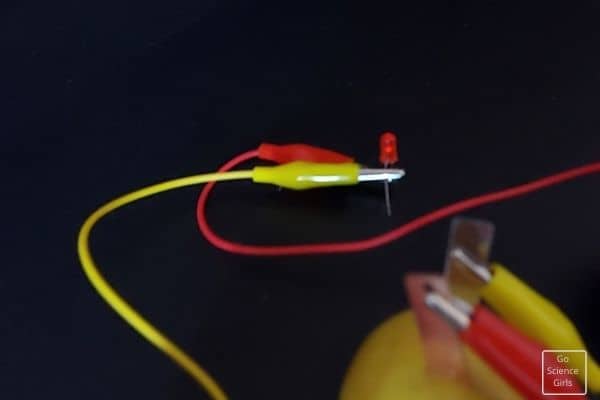
As soon as you connect, you will see the LED bulb emitting light from inside. If you want a better demonstration, switch off the light in the room or make the room dark and observe the results.
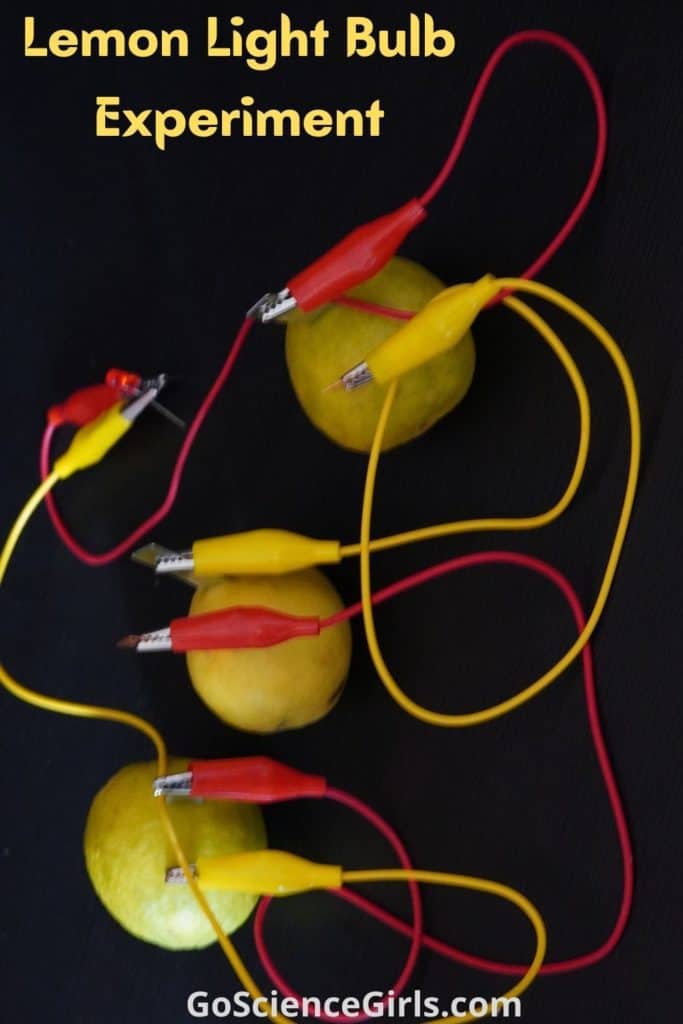
Tips: If you fail to see the LED bulb lighting up, recheck all your connections. Make sure the LED bulb is also in the right position and connected rightly. You can change the direction of the bulb to see positive results.
How do Lemons produce electricity and make an LED bulb glow?
For batteries to work, we need three things 2 electrodes and 1 electrolyte. One of these electrodes should have the ability to attract electrons. The one which attracts more electrons is called cathode. The other electrode which gives up electrons is called anode.
In our experiment, the copper strip has more electrons so that will work as cathode. But when you connect a cathode with an anode – electrons cannot move freely. This is because Zinc also has protons which cannot move through the wires.
Thats where the acidic solution comes in to play – the lemon juice. Here, lemon juice acts as electrolyte. Electrolyte removes electrons from the zinc through an oxidation process. These positively charged ions from zinc moves in the acidic solution which then collected by the copper.
Once the electrons moves into the copper – they tend to pull couple of hydrogen ions or protons from the acidic solution to reduce them by adding electrons.
To summarize – you don’t get the electricity from the lemon but the electricity is generated based on the chemical reaction that happens between zinc, copper and acidic lemon solution.
The positively charged copper strip is more likely to attract the free electrons released from the galvanic strip. However, the movement of electrons inside the lemons creates an electric circuit and the circuit closes. As a result, the electric circuit gets closed by connecting alligator clips to the LED bulb.
In this closed circuit, the free electrons from the zinc galvanic strip move towards the copper strip through the LED bulb and make it light up.
Interesting Electricity Experiments for Kids:
How to Bend water with Static Electricity
Static Electricity Hair Experiment
Modifications you can do to the Lemon Light Experiment to extend the activity
Check out the extension ideas of the Lemon light experiment below and explore more science and principles of electric circuits.
1) Try the experiment using different types of citrus-based fruits and check whether they work effectively in producing electric current. If so, then calculate the amount of current produced by observing the intensity of the light-emitting inside the LED bulb.
2) You can also check the same experiment using fruits that are alkaline and find out why they don’t produce electric circuits.
3) Replace the conducting solution, lemon juice with other solutions like vegetable juices and even aqueous solution, and experiment. Check the results!
4) You can try using other kinds of metals as electrodes. Find the reasons and dissimilarities in the outcome.
5) Try out different electricity conducting materials and check the best combination of metals that make good electric voltage.
6) Change the connections you made in the experiment and observe the changes happening while experimenting.
Important questionnaire to discuss with the children
If you are a teacher or home-schooler, find out the list of hint questions that make your students and children active through the experiment and improve their observing skills.
1) Why does lemon juice acts as a good conducting solution?
2) What are other good conducting solutions among fruits and vegetables?
3) Explain what is electric current and circuits.
4) What role does shorter and longer ends of LED bulb play in the experiment?
5) Does the LED bulb light up when two identical metals utilized in the experiment as electrodes?
6) Compare water and salt concerning the conducting power of electricity and explore the differences in conducting electricity.
